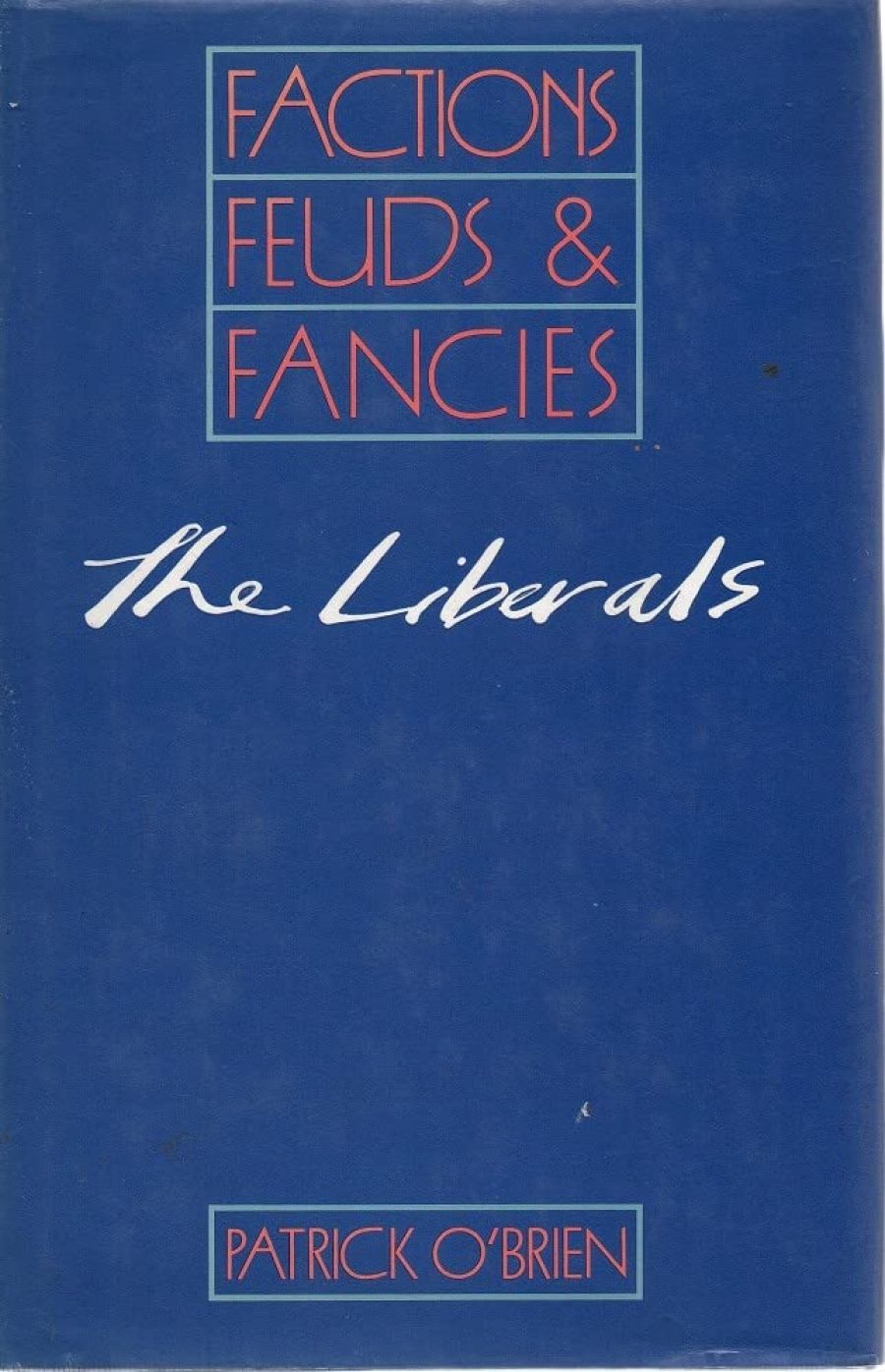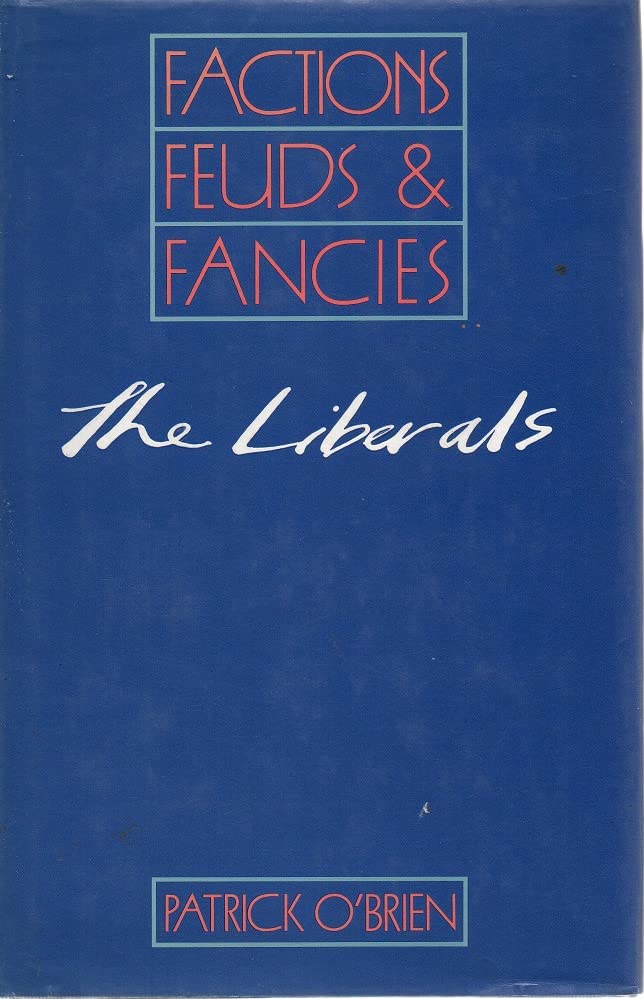
- Free Article: No
- Contents Category: Politics
- Review Article: Yes
- Article Title: Not Wet, Not Dry: Nor soggy?
- Online Only: No
- Custom Highlight Text:
Party factionalism in Australia has traditionally been located almost uniquely in the ALP Splits and dissensions have been part and parcel of the Party’s long history: and some of their colleagues with them, had, even joined their former opponents. The Split, extending fully in 1955–56, destroyed Labor as a coherent political force, and as a serious alternative to its rivals. But other parties also have faced dissension; not excepting the Liberal Party, a curious mosaic of ideas and personalities. Yet writers in the past have only glanced at this characteristic in the Liberal Party.
- Book 1 Title: The Liberals – Factions, Feuds and Fancies
- Book 1 Biblio: Viking, Penguin, $24.95, 161 pp
- Book 1 Cover Small (400 x 600):

- Book 1 Cover (800 x 1200):

But no one earlier went so far as Patrick O’Brien now has in The Liberals – Factions, Feuds and Fancies in identifying as many as eleven divisions in the Party. In this book, the author acknowledges several ‘tendencies’ within the Party, although he believes them to be not ‘quite like the factions in the ALP’.
The first group to be mentioned is the welfare state liberals who, while opposed to socialism, has shown by its programs a strong commitment to an expanding role for the State. O’Brien counts Robert Menzies among members of this group. Another group is the post-war idealists, dreaming of a vigorous, entrepreneurial Australia, which includes Liberal politicians like Charles Court of Western Australia, all of whom have been kindly disposed to big business and free markets. The third group is the Fabian Liberals. The author considers Hamer of Victoria to be most representative of this group. He points to Hamer’s acceptance almost without question of the WitlamUren package on regionalism. There are the wheeler-dealer Liberals (e.g., Askin), the small ‘I’ Liberal trendies or wets, the corporate executives and the Tory Liberals, described by O’Brien as a ‘dying species’. The eighth group to be identified is of the neo-conservative (also called economic-rationalist driest). It includes Hyde, Carlton, and Howard. This group favours free trade, minimal Government involvement, welfare for the needy only, and strong national defences. The damps are next to be discerned, identifying themselves with, the tradition of John Stuart Mill. The tenth group, the uglies, consists of right-wing reactionaries, most of them are located in NSW. Finally, there are the uncommitted, apparently a growing influence within the Party.
O’Brien concedes that these are not all distinct groupings within the Party. The Party, he writes, is a ‘looser coalition of individuals, groups and factions than even is the Labor Party’ and it ‘come(s) together on a national basis principally whenever there is a federal election’. But O’Brien does not explore all the ways in which every group is unlike any of the others. The damps, for instance, he says, have accepted ‘all the Party’s economic and social policies . . . laid down by the dries’ (pg 8); but he fails to show how they are different from the dries. Some groups are paid ·only scant attention. The Fabian Liberals are mentioned four times only. The reader learns very little of what they stand for. Perhaps this is due in part to the author’s own assessment that Fabianism is ‘all but dead’ (pg 213).
The author maintains that the pillars of the Liberal Party were the welfare statists and post-war idealists who provided it ‘with organisational skills, a political ideology and a social base? (pg 9). In the federal arena, the influence of the welfare statists is obvious. Under Menzies, Liberals held government from 19 December 1949, a little over five years after convening the Canberra conference that resolved to form the Party, to 20 January 1966, when he retired as Prime Minister. Yet why include Menzies, the man who so keenly fought Chifley’s bank nationalization scheme, among the welfare statists? O’Brien holds that Menzies was ‘induced’ by other Liberals to fight it. Nevertheless, his ‘highly protectionist view of the role of government in the economy and in society at large’ (pg 4) provides ample basis for including him in their ranks. Notwithstanding his anti-socialist and anti-centralist rhetoric, did not Central Government powers tend to grow under him?
But what of the post-war idealists who ‘dreamt of a vigorous entrepreneurial Australia’? What was their contribution? O’Brien sees Court as typical of this group, and points to that Premier’s record in government giving the state a large role to play in industrial development. But, again, O’Brien does not draw any apparent distinction between Menzies and Court; and one is left wondering whether differences arise out of rhetoric or practice?
The welfare statists and the post-war idealists are ‘ageing’ and ‘have faded away’. The author believes that Party to be ‘in search of a new ideology’. He predicts an expanding role of the neo-conservatives (economic-rationalist dries). But if O’Brien’s prediction is to be judged against the South Australian state election results of December 1985, recent events may already have proven him wrong, although it may be far too early to pass judgment on O’Brien’s assessment.
An obvious problem with O’Brien’s predication is its heavy reliance on a ‘new ideology’ as a means of saving the Party. ideologies may play a part in a party’s revival, but other factors may be equally, or more, important.
Recent interest in divisions within the Party has surfaced from leadership struggles in the Party over the last twenty years. Through Menzies’ long reign, many of the Party’s tensions were kept away from the public gaze, and many commentators wrongly concluded that the Party was more unified than the ALP. But since Menzies’ resignation in 1965, the federal parliamentary Liberal Party has had seven leaders (Holt, Gorton, McMahon, Snedden, Fraser, Peacock and Howard). (By comparison, Labor has had only four leadership changes – Calwell, Whitlam, Hayden and Hawke – since 1960.) NSW has worn worse for Liberals than other States, with seven leaders (Lewis, Willis, Coleman, Mason, MacDonald, Dowd and Greiner) departing in ten years, since Askin’s resignation in 1975.
The Liberals – Factions, Feuds and Fancies is further evidence of an upsurge of interest in the Liberal Party. However, unlike many other publications, this book is based extensively on private interviews and discussions with Liberals in the parliamentary and organisational wings of the Party, as well as their advisers. When discussing the prospects of the federal parliamentary party after the 1984 elections, in a somewhat prophetic vein the author includes more references to Howard than Peacock. Within weeks of publication of the book, Howard had replaced Peacock. Only time will tell on the verity of this coincidence!


Comments powered by CComment